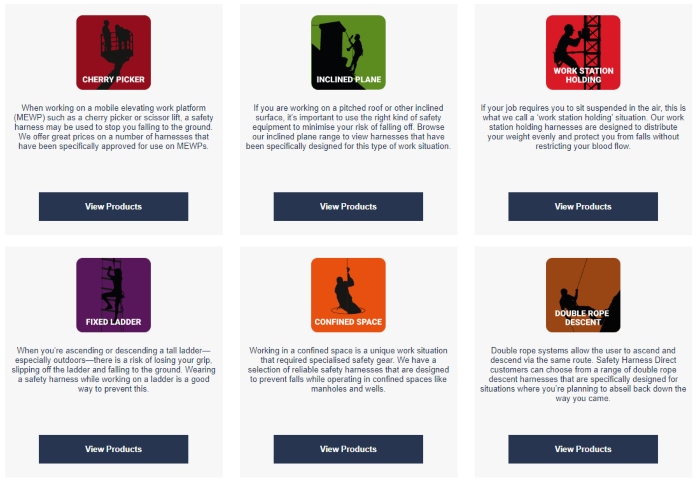
At Safety Harness Direct, we understand and care about your safety when working at height. If you work at height frequently, you will be well aware of the dangerous risks that come with this type of work. To give you the essential information you need to safely work at height, we have compiled all of our working at height guidance into one handy guide for your convenience.
If you're here for a quick answer, you can use the clickable contents below:
- What Is Working at Height?
- Work at Height Jobs & Examples
- Risks of Working at Height
- Working at Height Regulations
- Safety Tips for Working at Height
- Essential Work at Height Equipment
What Is Working at Height?
Put simply, according to the Health and Safety Executive:
"Work at height means work in any place where, if precautions were not taken, a person could fall a distance liable to cause personal injury."
This includes situations where:
- you are working above ground or floor level
- you are working near an edge, opening or fragile surface that you could fall through
- you are at risk of falling through a hole or opening in the floor / ground
Work at Height Jobs & Examples
Whilst you may consider work at height jobs to be extremely dangerous, you may be surprised that some domestic jobs are also considered working at height, including gutter cleaning, painting, window cleaning and roof cleaning.
In trade, the following professions work at height on a regular basis:
- Telecommunications Technicians
What Are the Risks of Working at Height?
There are many risks when working at height, especially since you will be working on an elevated area which will emphasise any injury or mistep you take. When you work at height, or you're planning to work at height, one of the most important things to conduct is a work at height risk assessment. A risk assessment means you can organise, plan and identify any precautions you will need to take before taking on your task.
The Work at Height Risk Assessment
A work at height risk assessment will assess any risks that could damage or harm the employee(s) working at height. Some examples of risks when working at height include: slips, trips, falls, dropping or falling equipment, mishaps with ladders, fragile surfaces, poor edge protection and insufficient PPE (to name a few).
Work at Height Mission Statement
A work at height mission statement is a description that outlines exactly how a task should be carried out. If all employees follow the working at height guidance set out in the statement, then you can be assured that the health and safety regulations have been managed in the particular scenario.
Mission statements can be produced and generated after conducting a risk assessment for working at height. Unlike a risk assessment, work at height mission statements are not a legal requirement, but they are incredibly useful for preventing life-changing injuries and for managing and monitoring complex construction work.
Work at Height Rescue Plan
A work at height rescue plan is an essential procedure carried out to prevent any accidents when working at height. To find an example of a work at height rescue plan, check out our blog by clicking the link.
Working at Height Regulations
Introduced in 2005, the Work at Height Regulations were implemented to 'prevent death and injury caused by a fall from height'. The Work at Height Regulations (2005) are what employers must use and follow - by law - to keep their employees safe on-site.
Most importantly, the first 3 steps outlined in the Work at Height Regulations are to AVOID, PREVENT and MINIMISE any risk of injury or death.
To do this, employers must ensure that:
- All work at height is properly planned and organised
- Employees working at height are competent in the task/job at hand
- The risks of working at height are assessed
- Appropriate equipment is selected and used for working at height
- The risks of working on, or near, a fragile surfaces is managed
- The equipment used is properly inspected and maintained
How can you ensure that someone is competent to work at height?
Someone who is competent to work at height will hold the relevant and necessary skills, knowledge and experience needed to carry out the task at hand safely and effectively.
It is the responsibility of the construction contractor, construction manager, and any employer, to ensure that the employees hired are competent enough to do the job with their own and others' safety in mind.
Top Safety Tips For Working at Height
As we have already discussed, there are many things can can go wrong when working at height. With the correct procedures such as a risk assessment and mission statements (as part of a job safety analysis) in place, you can minimise the risk of life-changing injuries - and even death.
Adhere to the following working at height guidance to stay on top of your game and ensure your work environment is safe for those around you.
1. Inspect Your Equipment On a Regular Basis
2. Be Cautious and Safe When Using a Ladder (you can read a bit about the HSE's ladder resource here)
3. Add Guard Rails When Possible
4. Provide Proper and Inspected PPE
5. Take Consistent Work at Height Safety Training
What Equipment Do You Need to Work at Height?
There is a variety of different pieces of PPE that you may require when working from height. Firstly, in order to select the right equipment, you will need to think about the task you are carrying out.
We have a variety of PPE available depending on your unique work situation. Simply click the link and select one of 12 work situations where working at height may be required.

Safety Harness Direct: Working at Height Guidance, Safety Harnesses, PPE and More!
We hope this blog has given you some guidance on working at height. If you require any further advice surrounding safety harnesses and working from height, do not hesitate to contact our helpful team.
Contact Us Buy a Safety Harness

